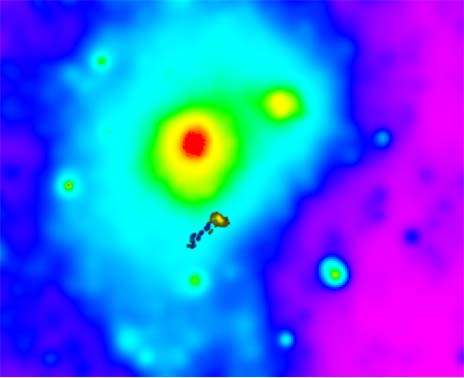Galaxy in its death throes may hold clues to birth of dwarf systems

(Phys.org) —A bright dwarf galaxy relatively close to Earth's Milky Way and trailing fireballs is the first clear example of a galaxy in the act of dying, scientists argue in new research.
The work gives a known galaxy new status and offers the potential for better understanding of the mysterious origin of dwarf elliptical galaxies, a subspecies of the universe's most common type of galaxy.
"We think we're witnessing a critical stage in the transformation of a gas-rich dwarf irregular galaxy into a gas-poor dwarf elliptical galaxy—the depletion of its lifeblood," said Jeffrey D.P. Kenney of Yale University, the principal investigator. "Until now, there has been no clear example of this transformation happening."
Kenney presented the research June 3 at the 222nd American Astronomical Society meeting in Indianapolis.
Star formation is the essence of galactic vitality, and many of the universe's known galaxies are active star factories. But due to gas depletion, many others have stopped making stars, rendering them in a sense lifeless. The subject galaxy—known as IC3418 and located deep inside the Virgo Cluster—is now all but totally out of gas, the researchers said.
When there's none left, the galaxy will no longer be fertile. "Stars, planets, and life can form only if a galaxy has gas to make them," Kenney said.
The Virgo Cluster is a mass of about 1,000 galaxies and the nearest large galaxy collection to the group that includes the Milky Way.
The core of IC3418 stopped making stars between 200 and 300 million years ago, according to the researchers. But its distinctive fireball-dotted tail shows evidence of recent star formation—within the last few million years or less, they estimate. The depletion of the core and the generation of the fireballs are probably the result of the process that's killing the galaxy: "ram pressure stripping."
In this process, the interaction of gases in the space between galaxies generates an enormous pressure that can force out an individual galaxy's interior gas, while leaving existing stars untouched. Ram pressure pushes gas away from the galaxy, forming stars that don't feel the ram pressure and remain behind.
The tail's fireballs—bright blobs of gas lit up by newly formed stars—are clear signatures of active ram pressure, according to researchers. Star formation is occurring at the heads of the fireballs.
"If you hold popcorn and unpopped kernels of corn in your hand and stick it out the car window as you drive, the wind caused by the car's motion through the air will blow away the popcorn but leave the denser unpopped kernels in your hand," Kenney said. "This is like the gas clouds in galaxies being blown out of the galaxy by the wind of cluster gas, while the denser stars remain behind."
The researchers used the WIYN 3.5-meter telescope in Arizona and the twin Keck 10-meter telescopes in Hawaii and performed both optical imaging and spectroscopy techniques.
Previous studies by other astronomers have proposed that IC3418 is experiencing ram pressure stripping. The new paper provides additional evidence and new details, and explicitly makes the case that the galaxy is an example of a galaxy near death.
"It's gratifying to find a clear example of an important process in galaxy evolution," said Kenney. "I enjoy digging through evidence to assemble a story about what happens to galaxies. I've come to think of myself as an intergalactic forensic pathologist—someone who studies the bodies of galaxies seeking evidence of traumatic events responsible for the present state of the galaxy."
The paper is titled "Transformation of a Virgo Cluster Dwarf Irregular Galaxy by Ram Pressure Stripping: IC3418 and its Fireballs." It will be submitted to Astrophysical Journal.
Journal information: Astrophysical Journal
Provided by Yale University



















